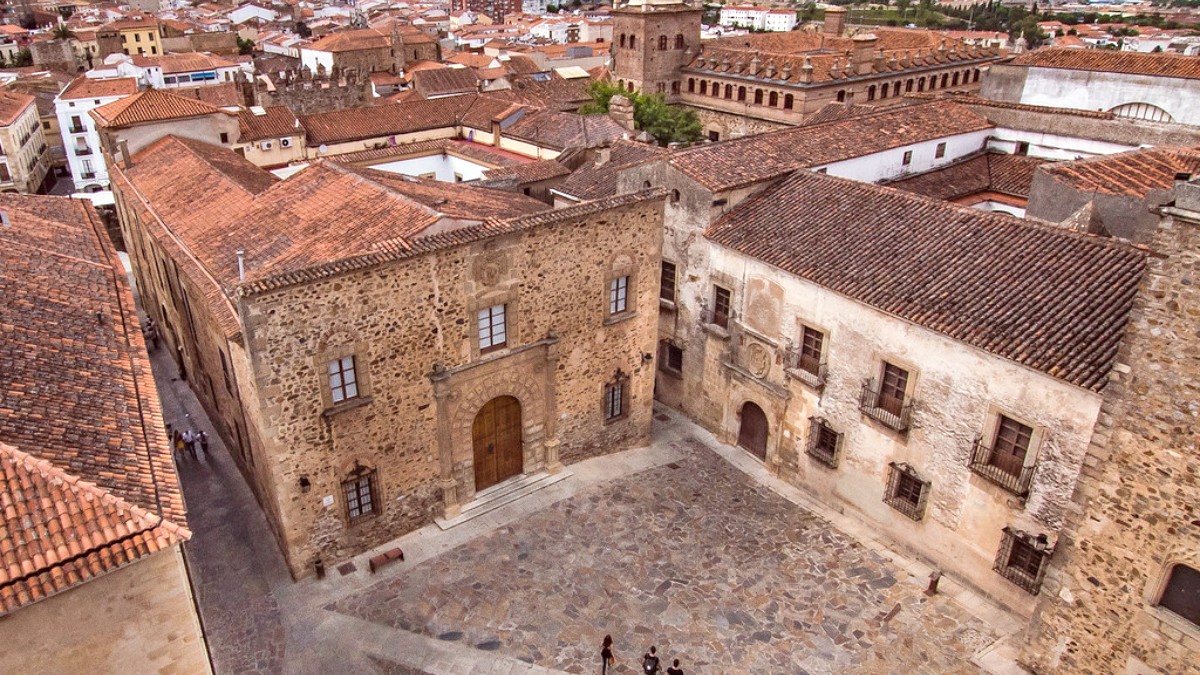
Extremadura, Spain
Extremaduran cuisine is robust, traditional, and deeply rooted in its agricultural heritage. It reflects the region's history, with influences from Roman, Arab, and Portuguese culinary traditions. The style focuses on high-quality, locally sourced ingredients, demonstrating a rustic yet refined approach to cooking.
The culinary identity of Extremadura connects to its landscape, specifically the dehesa, the open woodlands where Iberian pigs roam freely. This connection to the land shaped a cuisine valuing simplicity, flavor, and hearty preparations. Historically, it was a cuisine of shepherds and farmers, relying on cured meats, pulses, wild game, and seasonal vegetables. The region's location also meant an exchange of culinary ideas with Portugal and various cultures.
Extremaduran lamb is another regional delicacy, frequently roasted (cordero asado) or in rich stews (calderetas).
Partridge (perdiz), deer (ciervo), and wild boar (jabalí) are common in season, reflecting the region's hunting traditions.
From the Jerte Valley, these are available seasonally (typically late spring/early summer) and feature in desserts or are enjoyed fresh.
Acorn-fed Iberian ham. This gourmet delicacy, cured for years, is prized for its rich, nutty flavor and melt-in-your-mouth texture.
Find it at local delicatessens (charcuterías), gourmet shops, and high-quality restaurants. Often a starter plate. Consider a Spanish delicatessen.
A creamy, pungent sheep's cheese, from nearby Casar de Cáceres. Often served warmed, scooped onto bread.
Find it in specialty cheese shops and local restaurants.
A traditional shepherd's dish. It has fried breadcrumbs with garlic, paprika, and typically with cured meats or a fried egg. A hearty and flavorful dish, especially popular in cooler months.
Widely available in traditional restaurants and bars, especially for lunch.
Extremadura has excellent local wines, notably from the Ribera del Guadiana DO. Look for red wines from Tempranillo and Garnacha, and white wines from Cayetana Blanca or Pardina. Mahou and Cruzcampo are common Spanish beer brands throughout Caceres. Craft beer options are also growing.
An acorn liqueur, typical of the region, reflecting the dehesa's importance and its produce. Often a digestif. Enjoy robust Spanish coffee. Order a "café con leche" (coffee with milk), "café solo" (espresso), or "cortado" (espresso with a dash of milk).
Caceres has a diverse range of dining experiences, from high-end gastronomy to casual market stalls.
Many bars have affordable tapas and raciones (larger portions suitable for sharing). Look for 'Menu del Día' signs for economical lunch options, specifically on weekdays.
While Extremaduran cuisine is dominant, some international restaurants are present, mainly in the newer city center.
These options are increasingly available, notably in modern establishments and the Mercado de San Jorge. Traditional Extremaduran cuisine is meat-heavy, so explicitly ask for "platos sin carne" (dishes without meat) or "soy vegetariano/a" (I am vegetarian).
Options might include salads, vegetable stews (like pisto or gazpacho, seasonally), or Patatas Revolconas (confirm no bacon).
Awareness of gluten-free ("sin gluten") and other allergens is growing in Spain. Use translation apps or carry a dietary card for specific needs. Many establishments will try to accommodate.
Larger restaurants and hotels are generally better equipped for specific requests. Halal and kosher availability is very limited in Caceres.
Some local agencies or hotels may have private cooking classes on Extremaduran cuisine.
Food tours usually involve guided walks to various tapas bars, giving insight into local flavors and dining customs.
Visit Iberian pig farms, olive oil mills, or cheese producers in the surrounding region.
Check local calendars for events like the Extremadura Gourmet Fair or specific regional food fairs.
Street food, like food stalls on the street, is less common in Caceres. However, many bars have "tapas para llevar" or small portions of fried fish or empanadas from their counters.
Mercado de San Jorge has a modern take on market dining with various food stalls.
Atrio Restaurante creates an unique high-end culinary journey, an experience beyond a simple meal. The Mercado de San Jorge makes for a modern, casual dining experience where you can taste various dishes from different stalls.
Some convents in Caceres also sell traditional sweets ("dulces de convento") made by cloistered nuns, keeping centuries-old recipes—an unique and sweet cultural experience.
Some local agencies or hotels may have private cooking classes on Extremaduran cuisine, teaching you to prepare dishes like migas or caldereta. Food tours usually involve guided walks to various tapas bars.
Visit Iberian pig farms (dehesas), olive oil mills, or cheese producers (especially Torta del Casar) in the surrounding region.
Caceres cuisine is typical of northern Extremadura, focusing on the mentioned ingredients. While flavors are consistent across the region, local interpretations or specific recipes may vary slightly.
Street food, in the sense of food stalls on the street, is less common in Caceres. However, many bars have "tapas para llevar" or small portions of fried food.
Extremadura has excellent local wines, notably from the Ribera del Guadiana DO. Look for red wines from Tempranillo and Garnacha, and white wines from Cayetana Blanca or Pardina.
Specialized sweets or dishes appear during specific festivals. For example, "roscos" (sweet fried doughnuts) are common during Holy Week.
During mushroom season (autumn), restaurants may feature dishes with wild mushrooms.
Some convents in Caceres also sell traditional sweets ("dulces de convento") made by cloistered nuns, keeping centuries-old recipes.
A unique and sweet cultural experience, purchased through a rotating turnstile.
Some local agencies or hotels may have private cooking classes on Extremaduran cuisine, teaching you to prepare local dishes.
Food tours usually involve guided walks to various tapas bars, giving insight into local flavors and dining customs.
Opportunities to visit Iberian pig farms (dehesas), olive oil mills, or cheese producers in the surrounding region.